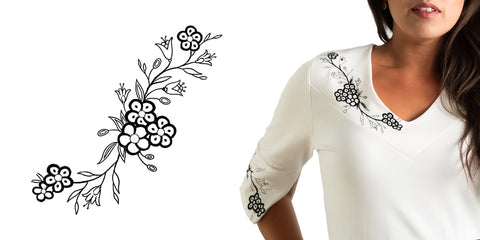Anne Mulaire - Story of our Héritage designs - Popup
Close
 The Red River Métis Nation were often referred to throughout history as the "Flower Beadwork People". Andréanne’s Métis ancestor, Catherine Mulaire, left samples of her embroidery in a style made of tiny sinuous flowers, long leaves, and tendrils. The flowers were often rosettes, layered in shades of red and pink. Métis artist, David Albert transformed these tiny sinuous flowers into a bold design symbolizing the new-found pride of the Red River Métis. He has named this design the «Prairie Pride Flower»
The Red River Métis Nation were often referred to throughout history as the "Flower Beadwork People". Andréanne’s Métis ancestor, Catherine Mulaire, left samples of her embroidery in a style made of tiny sinuous flowers, long leaves, and tendrils. The flowers were often rosettes, layered in shades of red and pink. Métis artist, David Albert transformed these tiny sinuous flowers into a bold design symbolizing the new-found pride of the Red River Métis. He has named this design the «Prairie Pride Flower»
 The Grey Nuns first introduced silk embroidery to the Red River Métis in 1844. Métis women used silk embroidery to decorate their clothing. They established a mission school in Ile-à-La Crosse where Catherine was born. Andréanne’s Métis ancestor Catherine, embroidered in the « Lake Winnipeg small flower style ». This style was generally made up of tiny sinuous flowers, long leaves, and tendrils. The flowers were often rosettes, layered in shades of reds and pinks. From samples of Catherine’s embroidery, still owned by her family, Andréanne was inspired to create the design she calls Catherine’s Vine.
The Grey Nuns first introduced silk embroidery to the Red River Métis in 1844. Métis women used silk embroidery to decorate their clothing. They established a mission school in Ile-à-La Crosse where Catherine was born. Andréanne’s Métis ancestor Catherine, embroidered in the « Lake Winnipeg small flower style ». This style was generally made up of tiny sinuous flowers, long leaves, and tendrils. The flowers were often rosettes, layered in shades of reds and pinks. From samples of Catherine’s embroidery, still owned by her family, Andréanne was inspired to create the design she calls Catherine’s Vine.




Story of our Héritage designs
We are proud to walk tall with our cousin nations and want to keep sharing our beautiful Indigenous stories with you.Prairie Pride Flower
 The Red River Métis Nation were often referred to throughout history as the "Flower Beadwork People". Andréanne’s Métis ancestor, Catherine Mulaire, left samples of her embroidery in a style made of tiny sinuous flowers, long leaves, and tendrils. The flowers were often rosettes, layered in shades of red and pink. Métis artist, David Albert transformed these tiny sinuous flowers into a bold design symbolizing the new-found pride of the Red River Métis. He has named this design the «Prairie Pride Flower»
The Red River Métis Nation were often referred to throughout history as the "Flower Beadwork People". Andréanne’s Métis ancestor, Catherine Mulaire, left samples of her embroidery in a style made of tiny sinuous flowers, long leaves, and tendrils. The flowers were often rosettes, layered in shades of red and pink. Métis artist, David Albert transformed these tiny sinuous flowers into a bold design symbolizing the new-found pride of the Red River Métis. He has named this design the «Prairie Pride Flower»Catherine’s Vine

Spirit of The North

The Aboriginal Plains people used Eagle feathers in ceremonies as a symbol of respect and healing. In the Indigenous culture, the Eagle is the symbol of Love in the Seven Sacred Teachings. To the Inuit people, the Polar Bear is regarded as the embodiment of the spirit of the North, an animal that possesses ancient wisdom. In true Métis fashion, David Albert captured the beauty and essence of both, using the bold Haida style in his design to pay homage to his Indigenous West Coast cousins.
Northern Willow

The Aboriginal people used the bark of the willow to relieve pain and fever. They chewed or boiled a tea from the willow's leaves or inner bark to relieve fever or other minor pain like toothaches, headaches, or arthritis. The willow is often given the nickname "toothache tree". Modern medicine has discovered that willow bark contains the medicinal extract, salicin, or salicylic acid (salix is Latin for willow). This chemical is the active ingredient in common aspirin. David Albert, a Métis artist, selected this important element of nature to create this design.
La Flèche

The Métis people helped shape the Canada of today, mainly in terms of the expansion of the west. The Métis became the link between the First Nations and their European allies, assisted by their wives who translated the native languages and helped resolve any cultural issues that arose. Métis Artist David Albert created this arrow (Flèche) to pay tribute to the trading activities between the Métis and First Nations people . The Métis were, in fact, astute business people. The flower represents the Métis, also known as the "flower beadwork people," and the arrow represents the First Nations and the connection between them.
Raven of Life

Raven can transform himself into anything. In Native culture, the Raven is the most powerful of mythical creatures. Traditionally, he symbolizes creation, transformation, it gave people fire and water, placed the trees and grass over the land and put the sun and moon in the sky. This design, by Aboriginal Métis artist David Albert, portrays the Raven becoming a branch of life.
Catherine’s Vine embroidery

The Red River Floral Embroidery

Representing harmony and pride, The Red River Floral was derived from traditional floral beadwork which is distinctively ‘Métis’. The Métis were known as the ‘Flower Beadwork People’. This print was created by David Albert, a Métis artist from Winnipeg who merged European floral designs with The Red River traditional flower (center one) which creates a connection between culture and earth.

